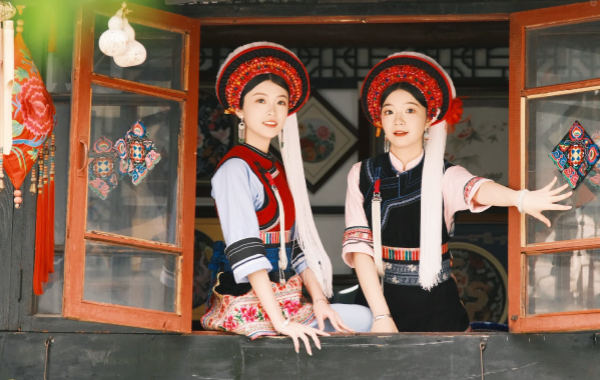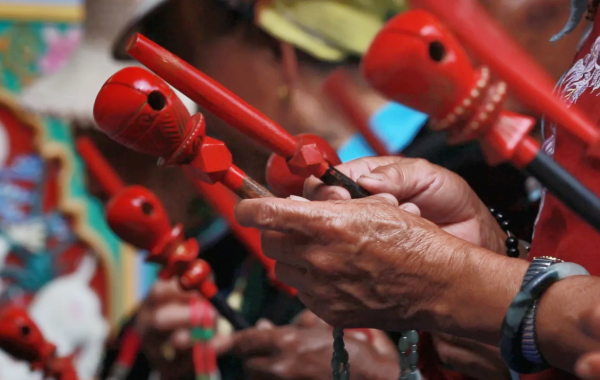Bai
Introduction

The Bai Nationality is a significant ethnic group in China, renowned for its rich cultural heritage, unique architectural style, and exquisite traditional crafts. Living in the picturesque regions of Yunnan, the Bai people have developed a harmonious relationship with nature, which is deeply reflected in their daily lives, customs, and artistic expressions.
 History
History
▪ Origin
The origin of the Bai people can be traced back to ancient tribes in the southwestern region of China. Over time, they absorbed elements from various neighboring ethnic groups and cultures, gradually forming their own distinct identity. Some theories suggest that the Bai people have historical connections with the ancient Di and Qiang tribes.
▪ Development
During the Tang and Song dynasties, the Bai-inhabited areas experienced significant economic and cultural development. The Nanzhao Kingdom (738 - 902 AD) and the Dali Kingdom (937 - 1253 AD), both established by the Bai people or with strong Bai influence, played crucial roles in promoting trade, art, and religion in the region. These kingdoms maintained close ties with the Central Plains dynasties as well as neighboring countries in Southeast Asia.
▪ Modern Times
In modern times, the Bai people have actively participated in the social and economic development of China. With the improvement of transportation and communication, the Bai-inhabited areas have become more integrated into the national economy. At the same time, efforts have been made to preserve and promote Bai culture, including language, traditional customs, and architectural heritage.
 Population
Population
▪ Quantity
As of the latest census data, the Bai population in China is approximately 2 million, making it one of the larger ethnic minorities in the country.
▪ Distribution
The majority of the Bai people live in Dali Bai Autonomous Prefecture in Yunnan Province, which is known for its beautiful scenery, including Erhai Lake and Cangshan Mountain. There are also Bai communities in Kunming, the capital city of Yunnan, as well as in Lijiang and other places in the province. In addition, small Bai populations can be found in some areas of Guizhou and Sichuan provinces.
 Economy
Economy
Traditionally, the Bai economy was based on agriculture, with rice, wheat, and corn being the main crops. The fertile land in the Dali region provided favorable conditions for farming. In addition to agriculture, the Bai people were also engaged in fishing, animal husbandry, and handicrafts.
In modern times, the Bai economy has diversified. Tourism has become an important industry, attracting visitors from all over the world with its unique cultural attractions and natural beauty. The development of agriculture has also shifted towards more specialized and high-value crops, such as tea, tobacco, and medicinal herbs. At the same time, traditional handicrafts, such as marble carving and tie-dyeing, continue to thrive and contribute to the local economy.
 Culture
Culture
▪ Language and Script
The Bai language belongs to the Tibeto-Burman branch of the Sino-Tibetan language family. It has its own unique phonetic and grammatical features. Although there is no widely used traditional written script, the Bai people have adopted the Chinese characters to write their language over time. In recent years, efforts have been made to standardize and promote the use of the Bai language, including the development of educational materials and the establishment of language training programs.
▪ Religious Beliefs
The religious beliefs of the Bai people are a blend of Buddhism, Taoism, and indigenous ancestor worship. Buddhism, especially Tibetan Buddhism and Han Buddhism, has a profound influence on Bai culture. Many Bai villages have Buddhist temples, where people go to pray and participate in religious ceremonies. Taoism also plays a role in Bai spiritual life, with its concepts of harmony with nature and the pursuit of longevity. Ancestor worship is an important part of Bai tradition, reflecting the people's respect for their ancestors and their belief in the continuity of family lineage.
 ▪ Clothing
▪ Clothing
Traditional Bai clothing is elegant and distinctive. Women's clothing often features white as the base color, with colorful embroidery and decorative elements. The upper garment is usually a short jacket with wide sleeves, and the lower garment is a long skirt. Women also wear headscarves or hats adorned with flowers and other ornaments. Men's clothing is simpler, typically consisting of a long-sleeved shirt and trousers, often paired with a waistcoat. In daily life, many Bai people now wear modern clothing, but traditional costumes are still worn during festivals and special occasions.
▪ Literature
Bai literature has a long and rich history, including oral traditions such as folk tales, legends, and songs, as well as written works. Folk tales often feature mythical creatures, heroes, and moral lessons, reflecting the values and beliefs of the Bai people. There are also many love songs and work songs that have been passed down through generations, expressing people's emotions and experiences in life. In terms of written literature, some Bai scholars and writers have made contributions in poetry, prose, and historical records.
▪ Transportation
In the past, the Bai people relied mainly on horses, mules, and boats for transportation. In the mountainous areas, horses and mules were used to carry goods and people. Boats were important for transportation on Erhai Lake and other rivers in the region. In modern times, with the development of infrastructure, cars, buses, and trains have become the main modes of transportation. However, boats are still used for tourism and local transportation on the lake.
 Science
Science
▪ Medicine
Traditional Bai medicine combines elements of Chinese medicine and indigenous healing practices. Bai healers use a variety of herbs, minerals, and animal parts to treat diseases. They also have a deep understanding of the local flora and fauna and know how to use natural resources for medicinal purposes. In addition to herbal remedies, Bai medicine also includes massage, acupuncture, and other traditional therapies. In recent years, there has been growing interest in integrating traditional Bai medicine with modern healthcare systems to provide more comprehensive medical services.
▪ Calendar
The Bai people have their own traditional calendar, which is based on the lunar cycle and agricultural seasons. This calendar is used to guide farming activities, such as planting and harvesting, as well as to mark important festivals and ceremonies. The traditional Bai calendar reflects the close relationship between the Bai people and nature and their deep understanding of the agricultural cycle.
 Art
Art
▪ Music
Bai music is characterized by its melodious tunes and unique musical instruments. Traditional Bai musical instruments include the sanxian (a three-stringed plucked instrument), the dizi (a bamboo flute), and the erhu (a two-stringed bowed instrument). Bai songs often have a lyrical quality, expressing love, nature, and daily life. There are also many folk music forms, such as work songs and dance music, which are performed during festivals and celebrations.
▪ Dance
Bai dance is vibrant and full of energy, reflecting the joyful and optimistic spirit of the Bai people. Traditional Bai dances include the "Lion Dance," "Dragon Dance," and "Flower Drum Dance." These dances are often performed during festivals and important events, bringing people together in celebration. The movements in Bai dance are often inspired by nature and daily activities, such as farming and fishing.
 ▪ Architecture
▪ Architecture
Bai architecture is renowned for its unique style and exquisite craftsmanship. The most famous example is the traditional Bai house, which is characterized by its "three rooms and one screen wall" layout. The houses are usually built with local materials, such as wood and stone, and feature intricate carvings and paintings on the doors, windows, and eaves. The white walls and black tiled roofs of Bai houses create a striking contrast against the blue sky and green mountains, forming a picturesque landscape. In addition to residential buildings, Bai temples and pagodas also showcase the high level of architectural art of the Bai people.
▪ Landscape
The Bai-inhabited areas in Yunnan are known for their breathtaking natural beauty. The combination of snow-capped mountains, clear lakes, lush forests, and fertile valleys provides a perfect backdrop for Bai culture. Erhai Lake, surrounded by mountains and Bai villages, is a particularly popular tourist destination. The natural landscape has not only inspired Bai artists and poets but also played an important role in shaping the traditional lifestyle and cultural traditions of the Bai people.
▪ Arts and Crafts
Bai arts and crafts are highly regarded for their fine workmanship and artistic value. Marble carving is a traditional craft of the Bai people, and Dali marble is famous for its high quality and unique patterns. Bai artisans can carve marble into various exquisite sculptures, vases, and decorative items. Tie-dyeing is another well-known Bai craft, which involves using natural dyes to create colorful patterns on fabric. Bai tie-dye products are popular both domestically and internationally for their unique beauty and cultural significance.
 Custom
Custom
▪ Etiquette
Bai etiquette is based on politeness, respect, and hospitality. When visiting a Bai home, guests are usually greeted with a warm smile and offered tea or other refreshments. It is customary to remove one's shoes before entering the house. During meals, guests are often served the best food and are expected to accept the offerings gracefully. Respect for elders is an important part of Bai etiquette, and young people are expected to show deference and obedience to their elders.
▪ Marriage Customs
Bai marriage customs are rich in tradition and symbolism. The process usually begins with matchmaking, where the families of the bride and groom arrange the marriage. After the engagement is confirmed, there are a series of ceremonies leading up to the wedding day, including the "betrothal gift" ceremony and the "dowry" ceremony. On the wedding day, the bride and groom wear traditional costumes and participate in various rituals, such as bowing to the ancestors and exchanging gifts. The wedding feast is a grand occasion, with relatives and friends gathering to celebrate the union of the couple.
▪ Festivals
The Bai people celebrate a number of important festivals throughout the year, each with its own unique customs and activities. The March Fair is one of the most famous Bai festivals, held annually in Dali. During the fair, people from different ethnic groups gather to trade goods, participate in traditional sports competitions, and enjoy various cultural performances. The Torch Festival is another significant festival, during which people light torches to drive away evil spirits and pray for a good harvest. Other festivals include the Mid-Autumn Festival and the Spring Festival, which are celebrated in a similar way to other ethnic groups in China but with some unique Bai elements.
▪ Diet
Bai cuisine is known for its fresh ingredients and delicate flavors. Fish from Erhai Lake is a staple food, and there are many ways to prepare it, such as steaming, frying, and boiling. Other common ingredients include vegetables, mushrooms, and ham. Bai dishes often feature a combination of sweet, sour, spicy, and salty flavors, creating a rich and diverse culinary experience. Some famous Bai dishes include "Acid Fish Soup" and "Braised Pork with Vermicelli." In addition to food, Bai people also enjoy drinking tea, and tea culture plays an important role in their daily lives.
 ▪ Funeral Customs
▪ Funeral Customs
Bai funeral customs are based on respect for the deceased and the belief in an afterlife. When a person passes away, the body is usually washed and dressed in new clothes. Family and friends gather to pay their respects and offer condolences. Funeral rituals are performed by monks or religious leaders, who recite sutras and pray for the soul of the deceased. The burial or cremation is usually followed by a mourning period, during which relatives and friends continue to offer support to the bereaved family.
What Our Clients Say?
Based on 10,000+ traveler reviews











